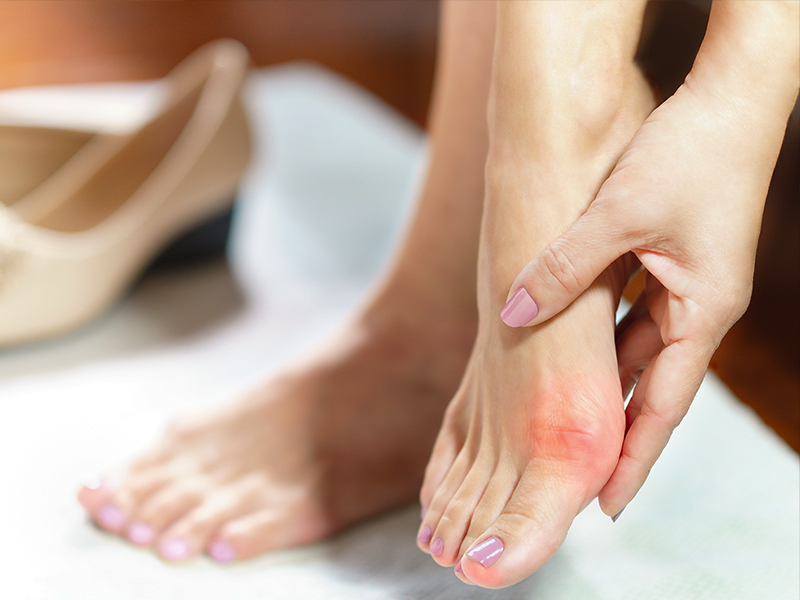Search
Find a Physician
Blog
Jun 20, 2024
Bunions are one of those things that the majority of people have heard of and may recognize but have no idea what it really is. A bunion is a term for the prominent bone in the inside part of the foot that sticks out when the great toe curves towards the smaller toes.
This lump over can be red, sore, unsightly, and get in the way of shoe ware.
Still, just knowing what it is doesn’t really help. Therefore, you need to look a bit deeper into how to treat bunion deformities. So, let’s go over some of your options.
The most common cause of bunions is prolonged pressure on the feet that compresses your big toe and pushes it toward the second toe. It's important to note that while many people may be exposed to the same conditions, not all of them will develop bunions. This suggests that other factors are also involved.
First, some people are more genetically predisposed to develop bunions. Abnormal bone alignment from birth may increase the risk or cause it even with less pressure applied.
Second, women are more likely to have trouble with bunions. They are more likely to develop arthritis, and damage to the joints in the foot can result in an increased risk of bunions.
Third, improper footwear, while the condition could be genetic, it is worsened by wearing narrow-toed and high-heeled shoes as well as shoes that are flat can contribute to the development of bunions.
Lastly, medical conditions like neuromuscular and connective tissue disorders can probably affect foot mechanics. This increases pressure and the chance of developing bunions.
Generally speaking, there are four grades of your foot conditions regarding bunion formations:
These stages are defined both clinically on presentation and by X-ray evaluation of the foot. With each subsequent stage, the pain will be worse, and finding the right footwear will be much harder.
While the majority of people know what bunion deformity looks like, the majority of them (the lucky ones) are completely oblivious to other symptoms.
Most shoe manufacturers do not account for this bulge, which makes finding the right footwear much harder.
There’s usually swelling and soreness around your big toe joint, which causes quite an issue.
Your big toe will have limited mobility, and there’s usually ongoing pain in the affected area. In other scenarios, the pain comes and goes.
There are a lot of different ways to approach this treatment, and even some at-home bunion treatment options that you could try out.
The simplest approach to this issue is to try making your footwear more comfortable. This means buying proper footwear, investing a bit more in padding and taping, and using orthotic inserts for those with hypermobility.
Since swelling is one of the bigger problems, you could always try reducing it with ice packs.
Additionally, you could try treating symptoms (like pain) with over-the-counter pain relievers like ibuprofen.
There are actually two more methods, each of which deserves a section of their own.
Bunion splints, also known as bunion braces, are a method that can be effective in treating some bunion symptoms. Most notably, they can slow down the progression of deformity. They alleviate pain, improve toe alignment, and improve comfort.
On the other hand, they’re not a cure, and, for some people, they might not work.
So, the answer to the question of whether bunion braces work depends on what you’re expecting of them. Suppose you’re looking for a way to make the conditions a bit better in most cases. If you’re looking to fix the issue, then the answer is no.
The situation with bunion stretches is similar to what we discussed in the previous segment. They’re effective in slowing down the progression of bunions, but they won’t cure them.
Some of the most effective stretches for bunions are:
When looking at how to treat bunion deformities, this is probably one of the first things you should consider. Why? Well, because it’s free and safe. Even if it doesn’t help, it won’t make matters worse.
If pain becomes excruciating and the deformity progresses rapidly, if you're seeking a solution that truly cures the problem, consider bunion correction surgery.
There are a few different types of bunion surgery:
The type of procedure will be determined by a specialist based on the condition of your deformity.
The procedure is done under anesthesia, which means that, during the procedure, you’ll experience no pain. After the anesthesia wears off, you will start feeling discomfort. During the first few weeks, the pain will be the most intense, and it will gradually wear off. Still, you should restrict movement during the early stages of recovery.
So, this is a brief rundown of what you’ll find when you start looking up how to treat bunion deformities. The simplest answer is that the only real “cure” is a surgical method. Everything else just slows down the progression and alleviates symptoms. At the same time, this is something you should discuss with your doctor. It all comes down to how serious the problem is, how serious the symptoms are, and what you can do to make things better.
This article was reviewed and approved by an orthopedic surgeon as we place a high premium on accuracy for our patients and potential patients.